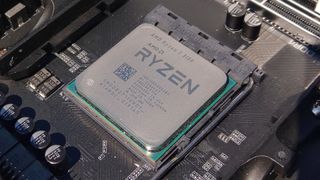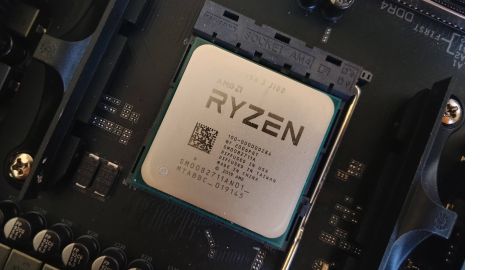Our Verdict
In isolation the Ryzen 3 3100 is a great budget chip. The problem is the 3300X performs far better and is only $20 more. Buy that instead.
For
- PCIe Gen 4 and Zen 2 architecture
- Includes Wraith Stealth cooler
- Overclocks well
Against
- Compares poorly to the 3300X
- Awaiting B550 motherboards
PC Gamer's got your back
The AMD Ryzen 3 3100, like the Ryzen 3300X, is a quad-core, 8-thread CPU designed for gamers on a budget. The 3100 has a 3.6GHz base clock with a turbo of 3.9GHz, while the 3300X has a base of 3.8GHz and a turbo of 4.3GHz. On paper then it just looks like the 3100 is slightly slower rendition of AMD's 3300X, although in reality there's more to it than that.
Cores/Threads: 4/8
Base clock: 3.6GHz
Max boost clock: 3.9GHz
L3 Cache: 16MB
Memory support: DDR4 3200MHz
Socket: AM4
Cooler: Wraith Stealth
Price: $99 (£99)
I already covered what makes the Ryzen 3 3100 tick in my review of Ryzen 3 3300X, but it's still worth talking about the pros and cons of this slightly cheaper $99 chip. It also means I can give it a score of its own, because while these two budget chips from AMD do have a lot in common, they are definitely different enough to warrant separate marks.
Both the 3100 and 3300X are built with two quad-core CCXs in the layout, but while the 3100 has two active cores in each CCX, the 3300X has all four active cores in just one CCX with a second lying dormant, presumably completely non-functional. The benefit of that is it reduces latency when communicating between those cores when they're in the same CCX, and that has a noticeable impact on performance. So even when you crank the clocks of the 3100 up higher, the 3300X still performs better.
There is an upside for the 3100 here though, and that is it is much happier when it comes to overclocking. I managed to crank the clocks and voltages up enough to take on the 3300X in the Cinebench R15 synthetic benchmark. Although in truth that didn't translate into any other test, with the 3300X still retaining an impressive lead. Also, running the 3100 that hard is not particularly practical or recommended, and even though you can easily overclock the 3100 with the stock air-cooler, you'd only really want to run it at 4.2GHz at 1.325V, or even less.
The main problem with overclocking this chip is that in order to keep it cool enough for a long-term OC, you're going to want to replace the Wraith Stealth it ships with. The moment you do that you begin to undermine its main reason for existing—this is primarily a budget CPU after all. In fact it feels like the Ryzen 3 3100 exists purely so that AMD can say it has a competitive gaming chip for less than $100.
Not a bad claim at all, but when you can pick up the Ryzen 3 3300X for only $20 more, which is unequivocally a much better chip, the whole reason for its existence begins to crumble. Essentially I can't foresee any scenario where I'd recommend saving the $20 to get the 3100 over the 3300X. The performance difference the 3300X holds over the 3100 is substantial, even when the cheaper chip is heavily overclocked. It isn't that the Ryzen 3 3100 is a bad CPU, far from it, it's simply that the 3300X is a much better one.









AMD Ryzen 3 3100
Wraith Stealth Cooler
Nvidia GTX 1070
Gigabyte X570 Aorus Master
16GB Thermaltake DDR4-3600
Samsung 850 Pro 1TB SATA SSD
Ikonik Vulcan 1200W PSU
We've already talked about the performance you can expect from the Ryzen 3 3100 in our review of the Ryzen 3 3300X, as we tested both at the same time. The 3100 lags behind its slightly more expensive sibling in pretty much every test, and doesn't fare quite so well against the quad-core, eight-thread Intel Core i7 7700K we used for comparison, although the difference isn't awful here either.
As with the 3300X the imminent release of the B550 motherboards is important to the overall value proposition, although you may be happier pairing this chip with a B450 to keep the overall spend down as B550s are generally expected to roll in at $100, well above what you can pick up a B450 board for today. This does mean you'll miss out on support for PCIe Gen-4 NVMe drives, but given they're pricier storage solutions anyway, that may be something which makes more sense when on the tightest of budgets.

There are no integrated graphics here either, so you're going to need to pair it with a graphics card. The general rule of thumb is that you should spend about twice as much on the GPU as you do your CPU, which in the case of this $99 CPU equates to something like a GeForce GTX 1650 Super. That cheap Turing card can be had for around $160, or a Radeon RX 5500 XT 4GB which offers roughly the same performance for around $170 (the Radeon RX 5500XT 8GB offers slightly better performance than the 1650 Super, but generally starts at $200).
So where does this leave the Ryzen 3 3100? In a bit of a tricky place to be honest. On its own it's a great budget processor that will give more expensive chips a run for their money. However, the problem here is still the Ryzen 3 3300X: It's better in every metric that matters, and costs just $20 more. The only thing the 3100 has going for it is the fact you can overclock it, which means it may be of interest to those who purely enjoy tinkering with such things.
In isolation the Ryzen 3 3100 is a great budget chip. The problem is the 3300X performs far better and is only $20 more. Buy that instead.
Alan has been writing about PC tech since before 3D graphics cards existed, and still vividly recalls having to fight with MS-DOS just to get games to load. He fondly remembers the killer combo of a Matrox Millenium and 3dfx Voodoo, and seeing Lara Croft in 3D for the first time. He's very glad hardware has advanced as much as it has though, and is particularly happy when putting the latest M.2 NVMe SSDs, AMD processors, and laptops through their paces. He has a long-lasting Magic: The Gathering obsession but limits this to MTG Arena these days.
